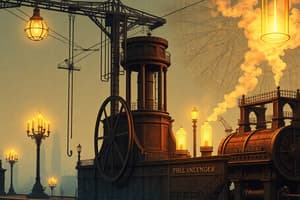Podcast
Questions and Answers
¿En qué sector la máquina de vapor reemplazó el poder muscular con fuerza mecánica?
¿En qué sector la máquina de vapor reemplazó el poder muscular con fuerza mecánica?
- En el transporte
- En la infraestructura pública
- En la agricultura
- En la manufactura (correct)
¿Qué mejoró significativamente gracias a las cosechadoras mecánicas impulsadas por motores de vapor?
¿Qué mejoró significativamente gracias a las cosechadoras mecánicas impulsadas por motores de vapor?
- La pesca de mariscos
- La caza de animales salvajes
- La molienda de harina (correct)
- La recolección de leña
¿Qué tipos de vehículos fueron impulsados por motores de vapor?
¿Qué tipos de vehículos fueron impulsados por motores de vapor?
- Barcos a vela
- Caballos de carga
- Autobuses a vapor (correct)
- Coches eléctricos
¿Cuál de los siguientes NO fue un uso común de la máquina de vapor?
¿Cuál de los siguientes NO fue un uso común de la máquina de vapor?
¿Qué función cumplió la máquina de vapor en la Revolución Industrial?
¿Qué función cumplió la máquina de vapor en la Revolución Industrial?
¿Cuál fue una de las invenciones más significativas de la Revolución Industrial?
¿Cuál fue una de las invenciones más significativas de la Revolución Industrial?
¿Quién inventó la primera forma primitiva de la máquina de vapor?
¿Quién inventó la primera forma primitiva de la máquina de vapor?
¿Qué mejoró James Watt en el diseño de la máquina de vapor?
¿Qué mejoró James Watt en el diseño de la máquina de vapor?
¿Por qué las primeras máquinas de vapor se limitaron principalmente a la minería?
¿Por qué las primeras máquinas de vapor se limitaron principalmente a la minería?
¿Qué inventor desarrolló una versión ligeramente más avanzada de la máquina de vapor llamada 'máquina atmosférica'?
¿Qué inventor desarrolló una versión ligeramente más avanzada de la máquina de vapor llamada 'máquina atmosférica'?
Flashcards are hidden until you start studying
Study Notes
Industrial Revolution and Inventions: Focus on the Steam Engine
The Industrial Revolution, spanning roughly from 1750 to 1860, brought about profound changes in various sectors such as manufacturing, agriculture, and transportation. One of the most significant inventions of this period was the steam engine. Let's explore how the steam engine impacted the Industrial Revolution and some related inventions.
Origins of the Steam Engine
Before the steam engine, manual labor dominated processes like mining and farming. However, the need for better tools to extract minerals from deep underground mines led to the development of the first primitive steam engines. Thomas Savery invented the earliest form of steam engine around 1698, followed by a slightly more advanced version called the atmospheric engine by Thomas Newcomen in 1712. Both of these early models largely remained confined to mining due to their inefficiencies and limited applications.
Efficiency Improvements: James Watt's Contribution
It wasn't until the Scottish engineer James Watt improved upon Newcomen's design that the steam engine truly began to transform industries. In 1775, Watt introduced a separate condensing chamber, resulting in a steam engine that was nearly twice as efficient and significantly reduced the amount of coal consumption compared to the earlier versions. This more compact and refined steam engine marked the dawn of the machine age and set the stage for the widespread adoption of steam power across multiple sectors.
Applications of the Steam Engine
With its vast potential for generating power, the steam engine was quickly applied to various fields:
-
Manufacturing: In factories, steam power drove countless machines, replacing muscle power with mechanical might. From spinning the yarn in textile mills to grinding flour in bakeries, steam engines revolutionized manufacturing speeds and precision.
-
Agriculture: Mechanical reapers and threshers, driven by yet smaller steam engines, simplified harvesting tasks and vastly improved crop yields.
-
Transportation: Steam power found its way into transportation systems too. Railroads, steamboats, and even steam-driven buses appeared as the steam engine propelled land, sea, and air vehicles forward.
Impact Beyond Industries
The steam engine touched every aspect of life, from domestic appliances to public infrastructure. For instance, steam engines powered fountains, steamships that crossed oceans, and steam traction engines that pulled heavy wagons in cities. Moreover, it laid crucial groundwork for future advancements. Electric motors emerged as direct descendants of the steam engine, although electricity itself, rather than steam, served as their driving force.
In conclusion, the steam engine played a critical role in initiating the Industrial Revolution and setting the foundation for rapid technological progress. Its influence stretched beyond mere factories and workshops, reaching into daily lives as an indispensable component of societal transformation.
Studying That Suits You
Use AI to generate personalized quizzes and flashcards to suit your learning preferences.




